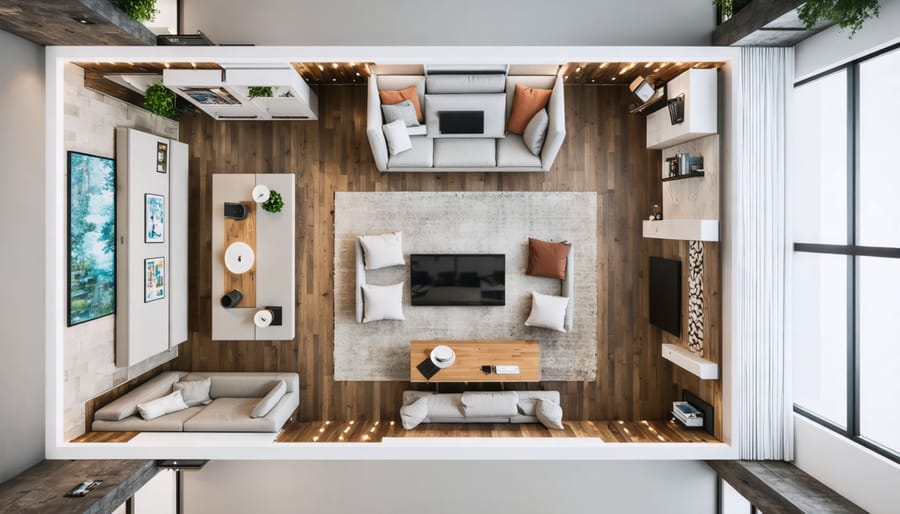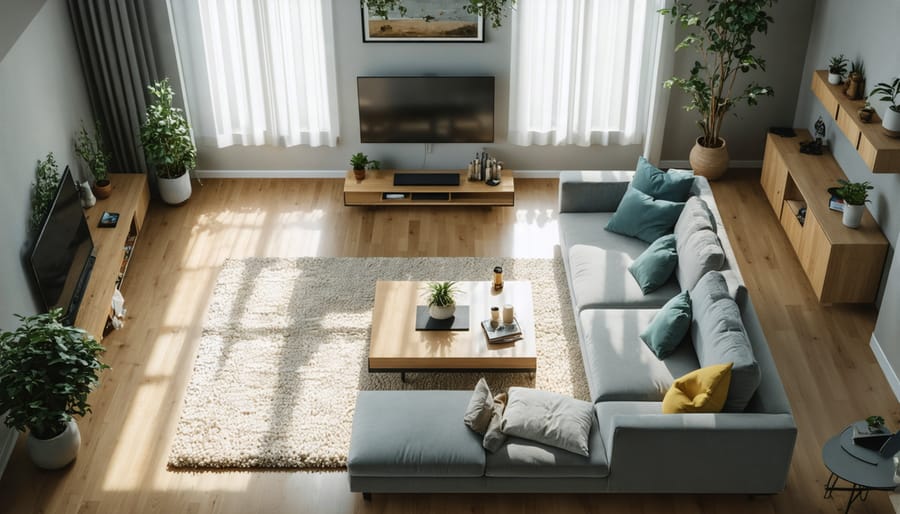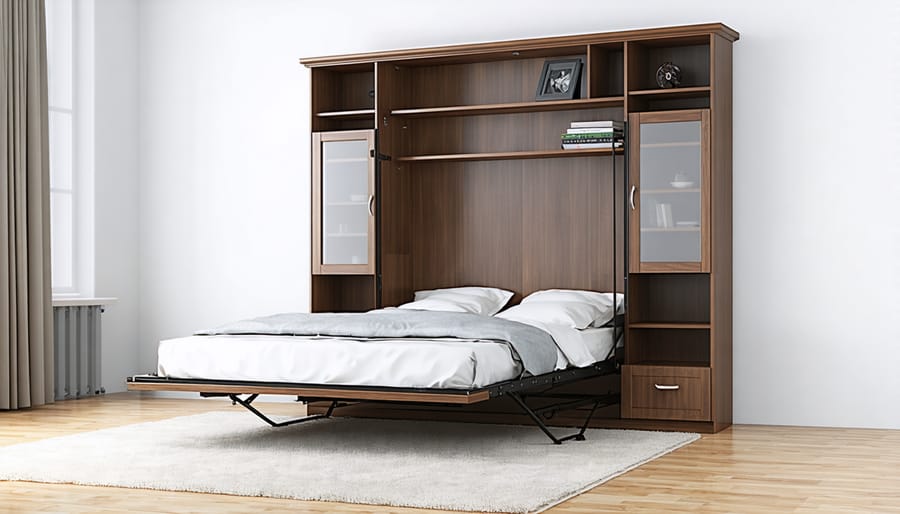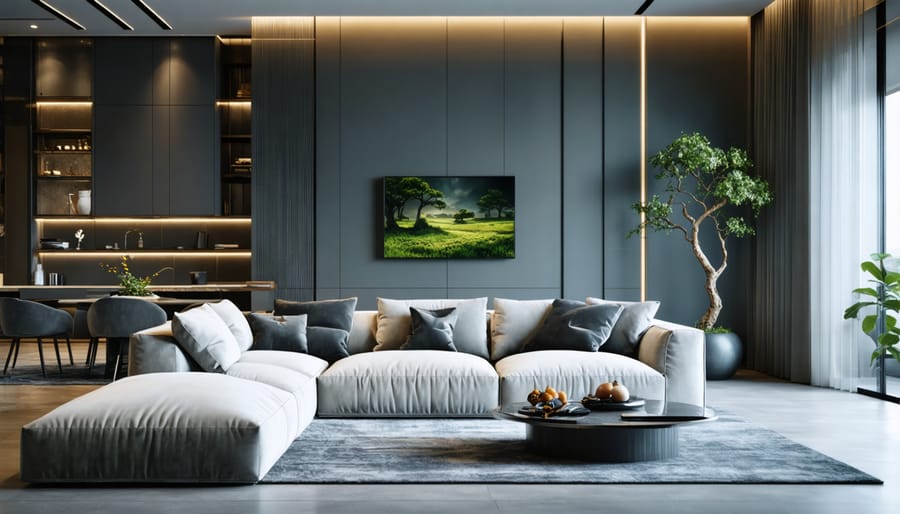
Transform Your Living Room Into a Space That Does It All (Without Looking Cluttered)
Transform your living room into a dynamic multi-purpose space by implementing smart zoning strategies that define clear areas for work, relaxation, and entertainment. Modern homes demand flexible spaces that adapt seamlessly from day to night, making every square foot count without sacrificing style or comfort. Strategic furniture placement, convertible pieces, and thoughtful storage solutions create distinct functional zones while maintaining an open, cohesive aesthetic that flows naturally.
Today’s living rooms serve as home offices, entertainment hubs, study spaces, and relaxation sanctuaries – often simultaneously. The key lies in selecting versatile furniture pieces that pull double duty, like ottoman coffee tables with hidden storage, fold-down desks that disappear when not in use, and modular seating that reconfigures based on your needs. Combine these practical elements with clever room dividers, mobile furniture solutions, and multi-functional lighting to create a space that transitions effortlessly between activities while maintaining a polished, intentional design.
By embracing this adaptable approach to living room design, homeowners can maximize their available space without compromising on style or functionality. The result is a sophisticated, hardworking room that serves multiple purposes while remaining inviting and aesthetically pleasing.
Smart Zoning: The Foundation of a Multi-Purpose Living Room

Creating Activity Zones
Creating distinct activity zones is essential to maximize your living space while maintaining flow and functionality. Start by mapping out your primary activities: relaxation, entertainment, work, and dining. Use furniture arrangement as natural dividers – position your sofa to create a cozy seating area, with a console table behind it to establish a clear boundary.
Area rugs are excellent for defining separate zones visually without physical barriers. Place one under your seating arrangement and another in your workspace or dining area. Strategic lighting also helps differentiate zones – use floor lamps for reading corners, pendant lights for dining spaces, and task lighting for work areas.
Room dividers like open shelving units serve double duty by creating boundaries while providing storage. Position them perpendicular to walls to separate spaces while maintaining an open feel. Consider using mobile furniture pieces like rolling desks or folding tables that can be easily moved when needs change.
Remember to maintain clear pathways between zones – at least 30 inches wide – to ensure smooth traffic flow. Use consistent color schemes and decorative elements across zones to maintain visual harmony while still distinguishing each area’s unique purpose.
Visual Division Techniques
Creating distinct zones within your multipurpose living room doesn’t require permanent walls. Area rugs are powerful tools for defining separate spaces – place a large rug under your seating arrangement to create a cozy conversation area, and a different rug to mark your home office or reading nook. The contrasting textures and patterns naturally guide the eye and movement through different zones.
Strategic lighting plays a crucial role in space division. Install pendant lights over specific areas like your dining space or desk to create visual boundaries. Floor lamps can anchor different activity zones, while table lamps add layers of ambiance and help distinguish between spaces.
Room dividers offer flexibility while maintaining an open feel. Consider using open shelving units that work double-duty as storage and space separators. Decorative screens can be easily moved when needed, and hanging curtains from ceiling tracks provides an elegant solution that can be opened or closed depending on privacy needs. Plants on stands or tall bookcases can create natural barriers without blocking light or making the room feel cramped.
Remember to maintain a cohesive color scheme across these divisions to ensure your room feels connected despite its distinct zones.
Furniture That Works Twice as Hard
Convertible Furniture Solutions
Transform your living room into a versatile haven with innovative multifunctional furniture solutions that adapt to your changing needs. The cornerstone of a flexible living space often lies in cleverly designed convertible furniture pieces that serve multiple purposes throughout the day.
Consider a sleek murphy bed that seamlessly folds into the wall, revealing a comfortable sofa during daytime hours. These modern systems often include integrated shelving and storage, making them perfect for guest accommodations without sacrificing your daily living space. Fold-down desks are another game-changer, providing a dedicated workspace that disappears when you’re ready to relax. Look for models with built-in cable management and charging stations to keep your tech organized.
Expandable tables are essential for any multi-purpose living room. Choose a coffee table that rises to dining height or a console table that extends to accommodate dinner guests. Many contemporary designs feature hidden storage compartments for extra functionality. For seating, opt for ottoman-bench hybrids with removable tops – perfect for storage while serving as additional seating or a footrest.
Smart nesting furniture, like stackable side tables or modular seating units, can be easily rearranged or tucked away when not in use. Look for pieces with wheels or lightweight designs that make transformation quick and effortless, ensuring your space can shift from a cozy living room to a productive workspace in minutes.

Hidden Storage Heroes
Every multi-purpose living room needs clever storage solutions, and today’s furniture designers have mastered the art of hiding functionality in plain sight. Ottoman coffee tables are the unsung heroes of living room storage, offering spacious compartments for blankets, gaming controllers, and magazines while serving as both seating and a surface for drinks.
Look for sofas with built-in storage under the seats – perfect for stashing extra pillows or seasonal decor. Modern entertainment centers often feature sliding panels or rotating sections that conceal gaming consoles and media equipment when not in use. Consider investing in window seats with hidden storage compartments underneath, transforming dead space into valuable storage while creating a cozy reading nook.
Floating shelves with secret compartments add intrigue while keeping essentials within reach but out of sight. For small spaces, opt for nesting side tables that can be tucked away when not needed, or choose hollow decorative poufs that open up to reveal storage space inside. Even traditional furniture pieces are getting smart upgrades – look for end tables with wireless charging capabilities and hidden USB ports, combining technology with tidiness.
Remember, the best storage solutions are those that blend seamlessly with your decor while making your life easier and more organized.

Tech Integration for Modern Living
Smart Storage Solutions for Electronics
Modern living rooms often house multiple electronic devices, but visible cables and charging cords can create visual clutter. Start by installing a cable management system behind your TV unit, using adhesive cable clips or cord covers that match your wall color. For a sleek charging station, convert a drawer in your entertainment center or side table by drilling a small hole in the back for cords and adding a power strip inside.
Consider furniture pieces with built-in USB ports and power outlets, like smart end tables or ottomans with charging capabilities. A floating media console can hide gaming consoles, streaming devices, and routers while maintaining a clean look. Install a cord management box near frequently used seating areas to keep phone chargers organized and accessible.
For remote controls and smaller devices, opt for decorative boxes or baskets with lids that complement your decor. Wall-mounted cable concealment channels can be painted to match your walls, effectively hiding TV and speaker wires. Remember to leave some ventilation space around electronics to prevent overheating, and label your cords discretely for easy identification during updates or troubleshooting.
Multi-Purpose Media Centers
Modern media centers have evolved beyond simple TV stands to become versatile command centers for both entertainment and productivity. Consider installing a floating media unit with adjustable shelving that can accommodate your TV, gaming consoles, and work equipment. Include built-in cable management solutions to keep wires tidy whether you’re streaming movies or conducting video calls.
A well-designed media center should feature a mix of open and closed storage. Use cabinets to hide office supplies and electronics when not in use, while displaying decorative items on open shelves to maintain a homey atmosphere. Install a pull-out work surface or fold-down desk that can be tucked away when movie night begins.
Smart furniture choices, like an ottoman with storage for electronics or a TV stand with built-in charging stations, can enhance functionality without sacrificing style. Consider incorporating a modular system that allows you to rearrange components as your needs change. LED strip lighting behind the TV or under shelves can create ambiance for entertainment while providing task lighting for work sessions.
Remember to position your media center at a comfortable viewing height and maintain adequate ventilation for electronics.
Quick-Change Artists: Flexible Design Elements
Mobile Furniture Systems
Mobile furniture systems are game-changers for multipurpose living rooms, offering instant flexibility whenever you need it. The key players in this category are pieces equipped with high-quality casters or wheels that can be locked for stability when stationary. Consider ottomans on wheels that double as storage and can roll wherever extra seating is needed, or sleek coffee tables with hidden wheels that transform into work surfaces.
Nesting tables are particularly valuable in this setup – they can be spread throughout the room when hosting guests and neatly tucked away when not in use. Look for modular sofas with wheeled components that can be easily rearranged from a movie night configuration to a social gathering setup in minutes.
For tech enthusiasts, mobile media centers and TV stands with wheels make it simple to adjust viewing angles or clear floor space for activities. Rolling bookcases and room dividers offer both storage and the ability to create separate zones instantly. The key is choosing pieces with robust wheels that match your flooring type – rubber casters work best on hardwood, while plastic wheels are ideal for carpeted areas.
Remember to keep pathways clear and establish “parking spots” for your mobile furniture when not in motion. This ensures your space remains organized while maintaining its dynamic potential.
Adaptable Lighting Schemes
Lighting plays a crucial role in transforming your living room from a daytime workspace to an evening entertainment hub. Start with a layered lighting approach using a combination of ambient, task, and accent lighting. Install dimmable LED ceiling lights for overall illumination, which can be brightened for work sessions or dimmed for movie nights.
Strategic placement of floor and table lamps creates task lighting zones perfect for reading or crafting. Consider swing-arm wall sconces near seating areas – they’re adjustable and free up valuable surface space. For ambiance, add LED strip lighting behind entertainment units or under floating shelves to create a cozy atmosphere during evening relaxation.
Smart lighting systems allow you to program different lighting scenes with a single tap on your phone. Create preset combinations like “Work Mode” with bright, cool-toned lighting, or “Movie Night” with subtle, warm lighting. Don’t forget about natural light – install adjustable window treatments that can filter daylight for screen viewing or open fully for yoga sessions.
For an extra touch of versatility, incorporate portable rechargeable LED lamps that can be moved around as needed, perfect for impromptu workspace lighting or creating intimate dining corners.
Style-Maintaining Storage Solutions
Storage solutions in a multipurpose living room don’t have to compromise your carefully curated aesthetic. The key is selecting pieces that serve double duty as both functional storage and stylish furniture. Consider ottoman coffee tables with hidden compartments, where you can stash magazines, remote controls, and gaming accessories while maintaining a clean surface for drinks and decor.
Built-in shelving units can be transformed into stunning focal points by mixing closed cabinet storage with open shelving. Display decorative items, books, and plants on visible shelves while tucking away less attractive necessities behind cabinet doors. Choose matching baskets or decorative boxes for open shelves to create a cohesive look while concealing smaller items.
Window seats with built-in storage drawers offer both charm and functionality, perfect for storing seasonal items or extra throw blankets. For tech-savvy homeowners, media consoles with cable management systems keep entertainment areas tidy while showcasing your TV and sound system.
Floating shelves installed in a geometric pattern can serve as both wall art and storage space. Select pieces in materials and finishes that complement your existing decor – think warm wood tones, sleek metals, or painted surfaces that match your color scheme.
Don’t overlook vertical space; tall bookcases or floor-to-ceiling cabinets maximize storage while drawing the eye upward, making the room appear larger. For a modern touch, consider modular storage systems that can be reconfigured as your needs change. Remember to maintain breathing room between storage pieces to prevent the space from feeling cluttered or overwhelming.
Creating a versatile multipurpose living room doesn’t have to be overwhelming. By focusing on flexible furniture arrangements, smart storage solutions, and adaptable design elements, you can transform your space into a functional hub that serves multiple needs while maintaining its aesthetic appeal. Remember to prioritize furniture that can serve dual purposes, like ottoman storage or fold-out desks, and invest in pieces that can be easily moved or reconfigured. Consider incorporating room dividers or mobile partitions for those times when you need distinct zones for different activities.
Keep your color scheme cohesive and opt for timeless pieces that will adapt to changing needs. Don’t forget the importance of proper lighting with adjustable options for different activities. Regular decluttering and organization will help maintain the functionality of your multipurpose space. With thoughtful planning and strategic implementation of these ideas, you can create a living room that seamlessly transitions from a cozy family gathering spot to a productive home office or entertainment zone.
Start small, implement changes gradually, and remember that your multipurpose living room should ultimately reflect your lifestyle while remaining practical and inviting.
